Bulletin – April 1993 Reserve Bank of Australia Index of Commodity Prices[*]
- Download 582KB
Introduction
Commodities (rural and non-rural) account for a significant proportion of Australia's exports. Even though tourism and manufactured exports have grown strongly in recent years, earnings from commodities were around two thirds of total export earnings from goods and services in 1991/92. This was despite the cyclically low level of prices. Furthermore, the volatility of commodity prices is an important source of fluctuations in export income and therefore in domestic income and activity.
Many commodity price indices are published. Some, such as The Economist Index, include several commodities which are not produced in Australia. The Reserve Bank Index of Commodity Prices is a more relevant index for Australia, providing a timely indicator of the prices received by Australian commodity exporters. It is based on the prices of 17 major commodities exported by Australia, accounting for around seventy five per cent of total commodity exports.[1] The Index, including its rural and non-rural components, is published monthly in terms of US dollars, Australian dollars and Special Drawing Rights (SDRs).[2]
Some changes to the Index are being made to make it more relevant and to update the base period to 1989/90, in line with recent revisions to statistics published by the ABS. This article reports on those changes; it also addresses some questions which are frequently raised by users. A technical description of the Index appears in the Attachment.
Rebasing the Index
Since February 1989, average commodity prices in 1984/85 have been used as the base for the Index. Until recently, this was consistent with the implicit price deflator for exports published by the Australian Bureau of Statistics (ABS). Recently, the ABS rebased constant price series and associated price deflators to a 1989/90 base. To maintain consistency, the RBA Commodity Price Index has been rebased to the same year. The rebased Index is spliced to the old Index at July 1984 using the ratio of the rebased Index to the old Index at that time as a splicing factor. This is consistent with the practice adopted in rebasing the ABS statistics. Historical data on the new base are available on request.
Graph 1 shows the all items Index in SDRs on the 1989/90 base; the Index on the 1984/85 base is also shown. The levels of the series are very similar as average prices in SDRs were very similar in the two base periods. Rebasing does not change the overall trends in the Index greatly, though the rebased Index declines slightly less from peak to trough than the old Index over the most recent cycle (26.3 per cent compared with 28.1 per cent). Rebasing does not change the interpretation of movements over the past twelve months.
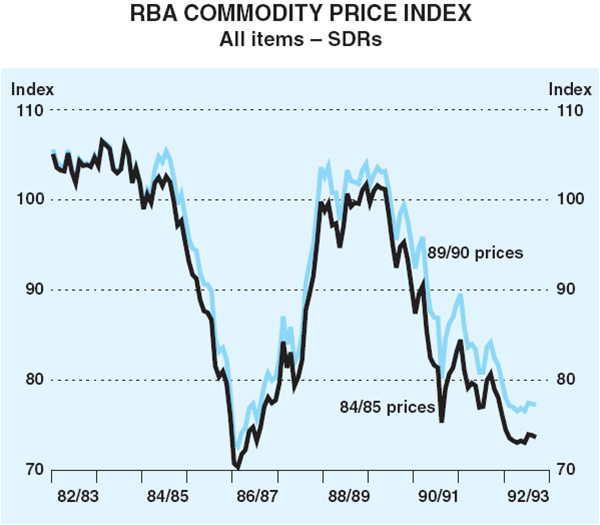
Rebasing the Index has had an impact on the weights (see the Attachment for an explanation of the weights in the Index and why rebasing changes those weights). Table 1 shows the December 1992 weights for some major commodities prior to, and after, the rebasing exercise. The shaded rows indicate those commodities for which the most significant changes in weight have occurred.
| 1989/90 base | 1984/85 base | |
|---|---|---|
| Wool | 16.0 | 11.9 |
| Gold | 14.2 | 14.9 |
| Coking coal | 12.7 | 16.0 |
| Steaming coal | 9.0 | 9.9 |
| Beef and veal | 8.9 | 8.4 |
| Iron ore | 6.8 | 8.1 |
| Aluminium | 6.7 | 5.6 |
| Wheat | 4.7 | 5.3 |
In 1989/90, commodity prices were high generally, as they were in 1984/85. The relative prices of some commodities, however, changed significantly between the two years. In particular, the price of wool rose by much more than commodity prices in general through 1987 and 1988. As a result, the weight of wool is significantly higher in the rebased Index. On the other hand, the weights of coking coal, steaming coal and iron ore all fell with the rebasing as their relative prices were lower in 1989/90 than in 1984/85.
Apart from rebasing, some other minor changes have been made to the Index. The iron ore price initially used in the Index has been replaced by a price more relevant to Australian exporters.[3] In addition, sorghum and butter prices will be excluded from the Index in future because of problems of data availability; the exclusion of these commodities makes no discernible difference to either the level of or changes in the Index.
Some Features of the Index
(a) Moving Weights
The Reserve Bank Index is a Paasche type index, using current period weights which change over time as the composition of exports changes. These changes in weights have effects separate from those of the rebasing noted above. Such changes in weights through time are in contrast to a number of other price indices where weights remain fixed between periodic rebasings.
Table 2 lists the weights for each of the 17 commodities in December 1992 and December 1987, in the rebased Index. The shaded rows indicate those commodities which experienced the most significant change in weights over the five year period.
| December 1992 | December 1987 | |
|---|---|---|
| Wool | 16.0 | 24.0 |
| Beef and veal | 8.9 | 7.9 |
| Wheat | 4.7 | 12.5 |
| Sugar | 3.4 | 4.5 |
| Cotton | 3.4 | 1.6 |
| Barley | 1.1 | 1.2 |
| Rice | 0.6 | 0.2 |
| Total rural | 38.1 | 51.9 |
| Gold | 14.2 | 5.2 |
| Coking coal | 12.7 | 13.5 |
| Steaming coal | 9.0 | 8.3 |
| Iron ore | 6.8 | 6.3 |
| Aluminium | 6.7 | 6.1 |
| Crude oil | 4.6 | 3.6 |
| Copper | 2.7 | 1.3 |
| Nickel | 2.3 | 1.0 |
| Zinc | 1.6 | 1.6 |
| Lead | 1.3 | 1.2 |
| Total non-rural | 61.9 | 48.1 |
In December 1987 (when wool exports were booming) the wool price accounted for almost one quarter of the Index. Since then, the market for wool has slackened and the weight of wool in the Index has declined sharply, although it remains the largest component of the Index. Wheat also had a much smaller weight in the Index in December 1992 than five years earlier, reflecting the relatively small quantity exported in 1992. On the other hand, the sharp rise in gold exports over the past five years has increased the importance of the gold price and it presently has the second largest weight in the Index.
Table 2 also shows the substantial change in the proportions of the Index which are made up of rural and non-rural commodities. In particular, the importance of the rural component has declined so that at the end of 1992, prices of rural commodities had a weight of 38 per cent in the total Index, compared with 52 per cent five years earlier.
(b) Currency Denomination
The Index is published in terms of three different units of measurement: US dollars, Australian dollars and SDRs. The choice of index on which to focus depends on the issue being considered.
The US dollar Index is of interest because most commodities are traded in world markets in US dollars. The US dollar price of commodities may, however, be affected by changes in the US dollar exchange rate relative to other major currencies. For example, if the US dollar depreciates sharply against all major currencies then, at an unchanged US dollar price, commodities would be cheaper in terms of other currencies. This could lead to a rise in demand for commodities relative to supply, with pressure for the US dollar price to rise.
The speed with which US dollar prices move will depend, among other things, on the existence and length of contracts. If commodities are being traded in active spot markets (for example, metals) the response may be very fast. In contrast, if the US dollar price is a contractual one, its adjustment will be delayed until the contract is up for renewal.
The RBA Commodity Price Index uses spot prices as far as possible, so that prices in US dollar terms are free to adjust to changes in the US dollar exchange rate. This means that, for the most part, movements in the SDR Index should be a better representation of underlying supply and demand for commodities than the US dollar Index as the SDR Index is less affected by changes in the US dollar exchange rate. This will be the case particularly over the longer term when the few contract prices in the Index have also had time to adjust. Graph 2 shows the US dollar and SDR indices. Both series have declined over the past few years. The decline in the US dollar Index has not been as steep, particularly over the past eighteen months, reflecting the fact that the US dollar has generally declined over that period.
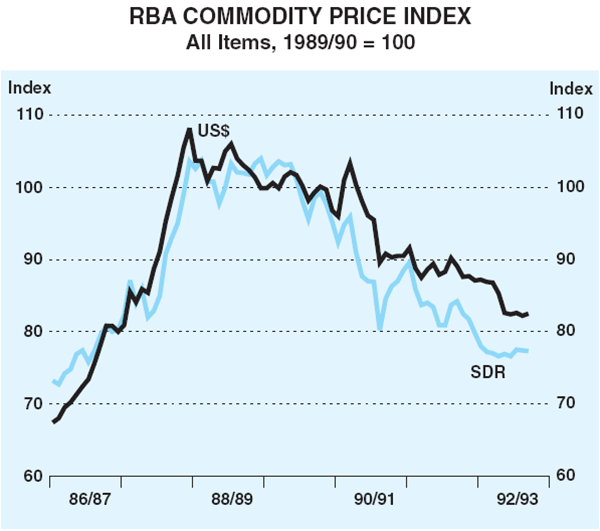
The Australian dollar Index is an indicator of the domestic currency price received by Australian commodity exporters. It reflects both world commodity prices and the Australian dollar exchange rate. A rise in world commodity prices will increase the Australian dollar price received by Australian exporters. Even with no change in the foreign currency price of exports, however, Australian dollar prices received by commodity exporters will change if the exchange rate changes; they will rise with a depreciation in the exchange rate and fall with an appreciation in the exchange rate.
Graph 3 shows the Australian dollar and SDR indices. The two series have diverged substantially over the past eighteen months, with the decline in world commodity prices during that time being roughly offset by the depreciation of the Australian dollar.
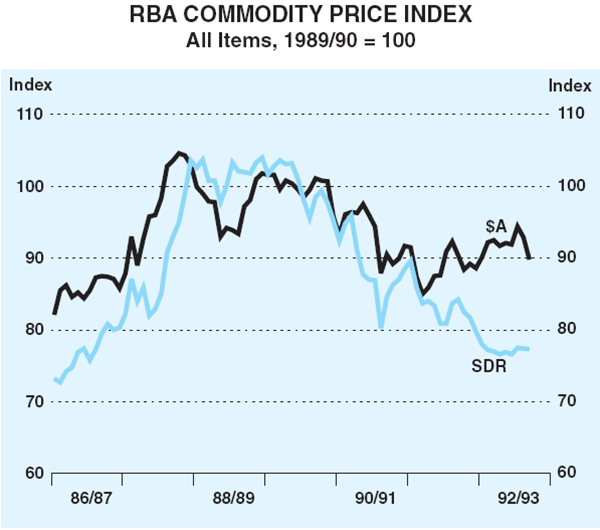
Comparison with Other Indices
Many other indices measure either commodity prices or Australian export prices more generally. The ABS export price deflator, for example, measures the Australian dollar price received for all Australia's merchandise exports, not just commodities. The RBA Index in Australian dollars moves very closely with the commodity components of this deflator.
Graph 4 shows the RBA rural Index and the ABS rural export price deflator; Graph 5 shows the RBA non-rural Index and the export price deflator for ‘resources’.4 Despite divergences from time-to-time, in both cases, the RBA Index moves closely with the relevant export price deflator. The advantage of the RBA Index is its timeliness.
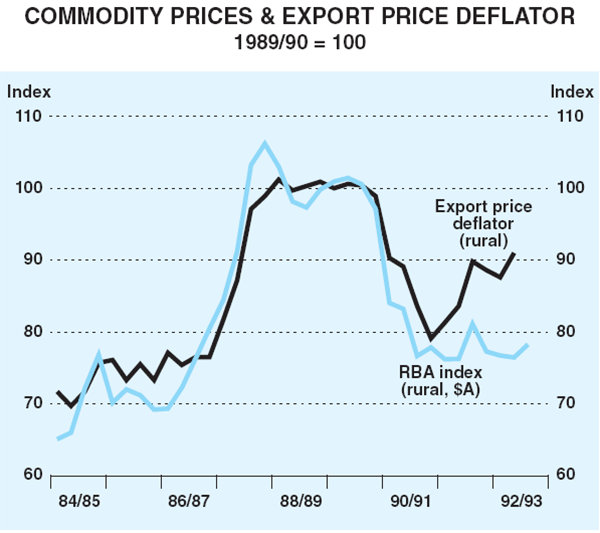
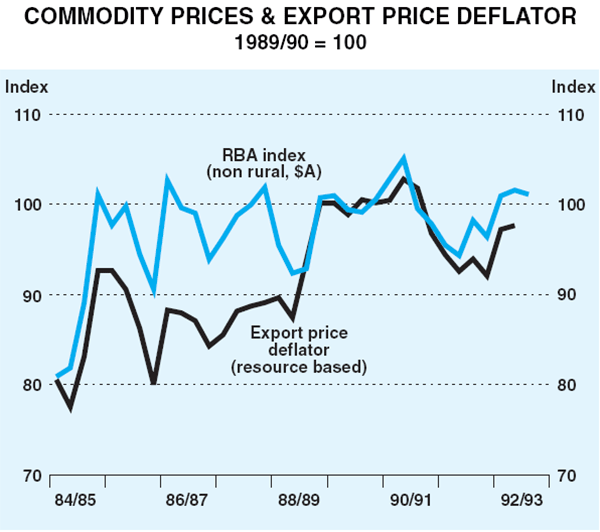
Divergences between the RBA Index and ABS export prices may arise when compositional shifts, particularly in quality and degree of processing, occur. These compositional changes are reflected in the ABS series but not the RBA Index, which summarises representative prices for commodities. Such a divergence emerged in 1991/92, due in part to an increase in the average quality of wheat exported and a fall in the amount of wheat sold to subsidised markets. These two effects increased the average return on wheat exports, and hence the relevant deflator, but were not captured in the price for wheat included in the RBA Index.
Other commodity price indices available in Australia include an index published by the Australian Bureau of Agricultural and Resource Economics (ABARE) and an index published by the Commonwealth Bank (CBA). The ABARE Index is a fixed weight index, based on the relative importance of the commodity groups in Australian exports for 1987/88. The Commonwealth Bank Index is a moving weight index calculated in a similar manner to the RBA Index. These indices have a commodity composition slightly different from that of the RBA Index (see Table 3).
| Index | Additions to RBA composition | Exclusions from RBA composition |
|---|---|---|
| ABARE | Uranium | Barley |
| Rice | ||
| Commonwealth Bank | Zinc ore | Barley |
| Alumina | Rice |
Graphs 6 and 7 show the RBA Index compared with the ABARE and CBA indices in SDRs; despite the slight differences in composition and construction, the indices move closely together.
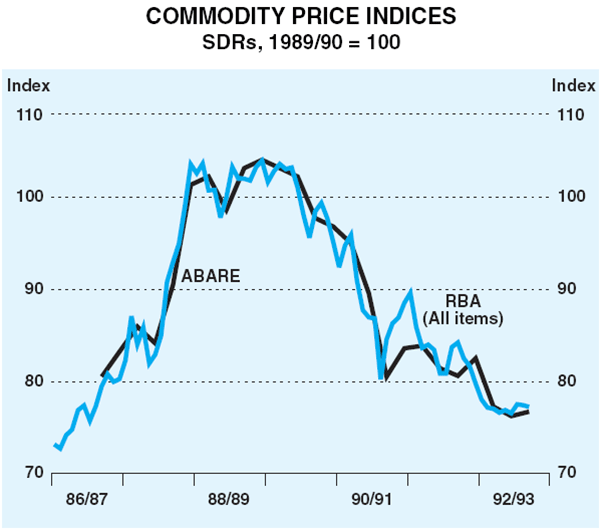
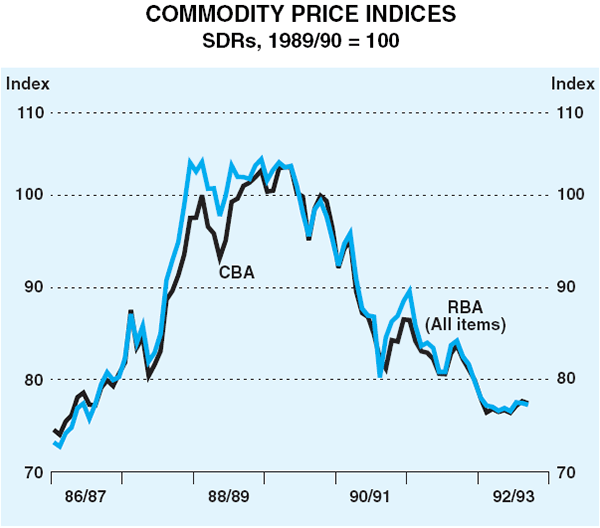
Other commodity price indices available include The Economist Index, the IMF Index of non-oil commodity prices, and the Commodity Research Bureau (CRB) Index of commodity futures prices. The first two indices are constructed by applying fixed weights to current commodity prices and cover a broader range of commodities than the RBA Index. The Economist Index incorporates 27 commodities while the IMF Index includes 33 commodities. The CRB Index is a simple average of futures prices of 21 commodities, so that the same weight applies to each price.
Over the long run, Australian commodity prices follow the movements in these broader indices of commodity prices. Nevertheless, there are sometimes substantial divergences reflecting compositional differences. In general, each of these three international indices include some rural commodities which the RBA Index excludes: rural commodities account for between 70 and 80 per cent of each of these indices, and mineral and energy prices correspondingly receive a much lower weight than in the RBA Index. For this reason, a specifically Australian index is more relevant when considering the earnings of Australian commodity exporters.
Graph 8 shows the RBA Index and The Economist Index, both in SDRs. The Economist Index rose much more than the RBA Index through 1987/88 and has fallen much further since its peak. More recently, The Economist Index has risen quite sharply while the RBA Index is yet to show any strong or consistent signs of recovery. The CRB Index also has risen recently (see Graph 9). The CRB Index is in US dollars so Graph 9 shows the RBA Index in US dollars (as well as SDRs) for comparison. The rise in the CRB Index is not reflected in a rise in the RBA Index. Like The Economist Index, it reflects price rises in commodities which are either not produced in Australia or comprise only a relatively minor part of Australia's production and exports.
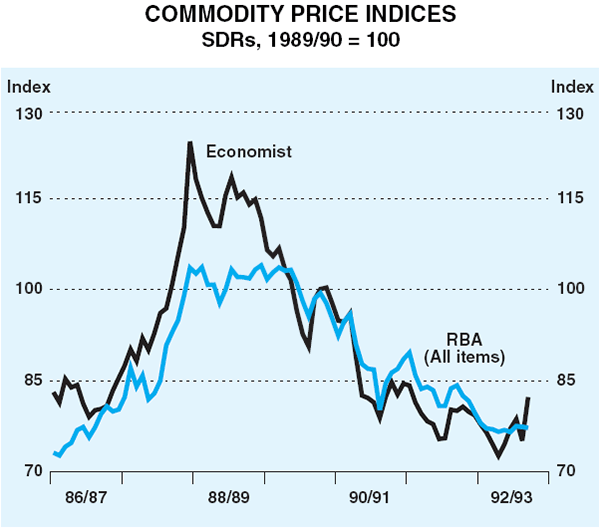
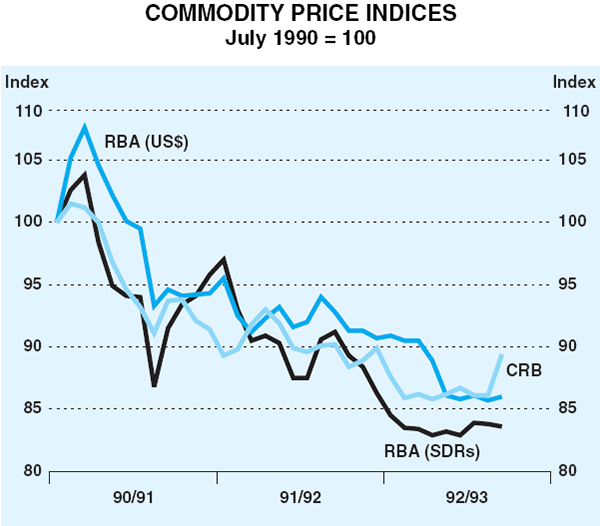
Attachment: Calculation of the Commodity Price Index
The RBA Commodity Price Index is calculated as:
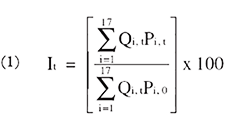
where:
Qi = quantity of commodity i exported (i = 1 to 17);
Pi = price of commodity i (i = 1 to 17);
0 = base period;
t = current period; and

The quantities are simple moving averages of the physical amounts of each commodity exported in the preceding twelve-month period. For example, the quantity of coking coal used to calculate the December 1992 Index is the average monthly tonnage of coking coal exported over the twelve month period from January 1992 to December 1992. This allows for the changing composition of exports while smoothing out the monthly volatility.
Abstracting from the moving average, the numerator measures the value of current exports at current prices while the denominator measures the value of those same exports at base period prices. The Index therefore has a similar interpretation to that of an implicit price deflator – the ratio of the current price value of commodity exports to the constant price value of those exports.
The weights applying to each price are not obvious from equation 1. To see this, note that equation 1 can be expressed as

That is, the Index can be expressed as a weighted sum of current commodity prices with the weights equal to

These ‘weights’ have no intuitive interpretation; the numerator is a quantity (such as tonnes of coal) while the denominator is a value (the value of today's exports at base period prices).
Simple algebraic manipulation yields an expression which is more readily understood. Multiplying top and bottom of the ith term by



In this expression, a price index for each commodity – its current price relative to its base period price – is weighted by a factor and these are then summed over all commodities. The weights (αi) are the ratio of today's exports of commodity i valued at base period prices to today's total commodity exports valued at base period prices.
There are two important features to note about these weights. First, because they depend on current export quantities, they will move over time as the composition of commodity exports changes. The changes can be quite substantial. Second, because they also depend on prices in the base period, weights at a given point in time will change when the base period is changed. Even though the quantities do not change with rebasing, the weights will change if the relative prices of commodities are significantly different between the two base periods.
Footnotes
Previous articles on the Commodity Price Index appeared in the Bank's February 1989 Bulletin and December 1987 Bulletin. [*]
The original 19 commodities represented in the Index were listed in the Bulletin article of December 1987. Sorghum and butter will in future be excluded from the Index (see Rebasing the Index section). [1]
The Special Drawing Right is a unit of measurement used by the International Monetary Fund based on the currencies of the five major industrial countries – the U.S., Japan, West Germany, the U.K. and France. [2]
The new price is the price negotiated for exports to Japan of Australian Hematite Fines, obtained from the Australian Bureau of Agricultural and Resource Economics. [3]